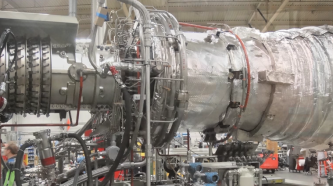Jet turbine lands on campus

The jet turbine that will nearly double the generating capacity of UMass Medical School’s power plant arrived on campus Feb. 9 after a cross-country journey from its California manufacturing plant.
The following day, a crane and rigging crew worked carefully, inch by inch, to lift the 57-ton machine off its flat-bed trailer and maneuver it into the new turbine hall now under construction on the south side of the power plant.
“This is a huge milestone,” said Joseph Collins, director of energy resources. “The gas turbine is the heart and soul of this plant expansion.”
The power plant is being expanded to accommodate the campus’s growing demand for steam, electricity and chilled water. The new turbine is a Taurus 70, manufactured by Solar Turbines of San Diego. It is a modified jet engine that will burn natural gas. At the front end of the turbine, a spinning shaft will turn a generator to produce electricity directly. At the back end of the turbine, exhaust will flow at 910 degrees into a heat recovery steam generator (HRSG) to produce some 60,000 pounds of high-pressure steam per hour. That steam will do triple duty: It will drive two of the plant’s existing electric generators, then move through the campus’ steam-line network to heat buildings and drive compressors that make chilled water for the campus’s cooling systems.
“Now that the turbine is in place, they’ll start constructing all the subsystems involved in its operation and get us ready for our first-fire test, sometime this fall,” Collins said.
When the expansion is completed, the plant’s maximum electrical output will increase from 10 to 17.5 megawatts. The existing plant produces all the steam and chilled water currently needed on campus, and about half of the electricity used. The expanded plant will be able to meet nearly all of the campus’s electrical demand, even after the Albert Sherman Center opens.
Even though the power plant is growing, its environmental impact will actually be reduced. When the new gas turbine is operating, one of the plant’s original gas and oil-fired steam boilers will be taken off-line and kept in reserve as an emergency back-up. Since natural gas burns cleaner than oil, and the new jet turbine is highly efficient, the expanded power plant will actually have lower green-house gas emissions, despite its added energy capacity.
